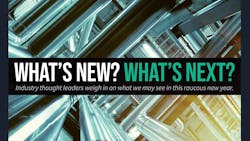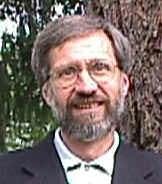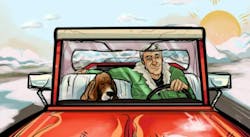As 2024 gathers momentum, our industry is facing a slew of regulatory changes, an ongoing post-pandemic IAQ revolution, an economy that continues to confound expectations, and a global geopolitical climate as unsettled as the climate, itself.
With all that in mind, HPAC Engineering once again contacted several industry thought leaders, to get their perspectives on what we should all be looking for in the months ahead. From decarbonization and next-gen recruitment to energy efficiency and artificial intelligence, their answers lay out a dizzying array of challenges and opportunities that will only get more complicated in yet another controversial U.S. election year.
Read on to get their takes...
GINGER SCOGGINS, PE, ASHRAE Fellow, 2023-24 ASHRAE President
Decarbonizing the built environment will require an incredibly broad array of actions and ASHRAE is proud to be at the forefront through the development of standards and guidelines that address embodied and operational carbon, as well as energy efficiency. The pledge that many countries just made at COP28 to triple the world’s renewable energy capacity and double energy efficiency by 2030 will be a huge step forward in achieving climate change goals and ASHRAE stands ready to provide leadership through our technical guidance and advocacy.
As ASHRAE remains committed to addressing the climate crisis through its focus on building decarbonization, artificial intelligence (A.I.) is expected to influence HVACR broadly in the areas of enhanced energy efficiency of systems through real-time performance data, smart building management, fault detection and improved indoor air quality (IAQ), among other insights. This will be an evolving area for our industry.
ASHRAE is also determined to engage with the next generation. The Society recognizes the importance of fostering a vibrant community of young professionals and is actively engaging with several programs and strategies aimed at attracting, supporting, and empowering emerging talents in the HVACR industry.
Toward that end, the Young Engineers in ASHRAE (YEA) facilitates networking events, mentorship programs and educational resources specifically designed to support the unique needs and aspirations of early-career engineers. ASHRAE also invests in the future of the industry by providing scholarships and research grants to students pursuing careers in HVACR. These opportunities not only alleviate financial burdens but also encourage academic excellence and innovation.
DEREK ENSIGN, PE, CEM, CxA, LEED AP, Director, Energy Design Engineering, Southland Industries
The HVAC industry is currently undergoing a paradigm shift with significant challenges affecting all entities — from manufacturers and engineers to contractors and owners. Although the industry is still facing material challenges and component shortages resulting in long lead times, there are emerging challenges that are even more impactful for the long term.
This industry has long trended toward incremental improvement in equipment, products, and system/design approaches to meet evolving energy codes and standards. Yet, there are new agents of change in the HVAC market provoking trends and awareness on environmental impact.
Such new challenges not only include exceeding energy efficiency requirements, but they encompass developing new equipment, strategies, and design approaches to meet the additional demands of refrigerant phasedown and reductions in GWP, decarbonization/electrification, emissions, and carbon footprint, while improving sustainability. Currently, with multiple variables in a dynamic state of change, emerging trends can be unpredictable.
Despite the challenges, the industry is responding to changes with advancements in technology such as new diverse offerings and applications of heat pumps coupled with renewable energy microgrids, including solar photovoltaic, battery energy storage, and co-generation. Although the current and future industry trends are still evolving, the industry is continually improving towards resiliency, reliability, and efficiency to minimize global impact.
MIKE WOLF, PE, 2023-2024 president, Air Movement and Control Association (AMCA) International
New performance regulations for commercial and industrial fans and blowers sold in the United States are now in effect. These regulations include a U.S. Department of Energy (DOE) test procedure, impending national DOE energy standards, and an efficiency mandate from the California Energy Commission (CEC). AMCA has engaged collaboratively with the DOE, the CEC, and industry partners from the start to develop practical rules that balance energy conservation, emissions reduction, and ease of implementation. Our shared aim has been to craft straightforward requirements that effectively serve manufacturers, practitioners, asset owners, and the environment.
Efforts to bring data-submittal and verified labeling specifications in line with the new regulations continue. AMCA staff and members have maintained close coordination with both the DOE and the CEC to incorporate required certification elements into an enhanced AMCA Certified Ratings Program (CRP). By integrating federal and state database and reporting mandates directly into the CRP, we aim to streamline compliance for AMCA members while promoting consistency and reliability for end users. This collaborative approach will facilitate cost-effective implementation across our industry as the new performance standards and procedures evolve.
ELIZABETH BEARDSLEY, Senior Policy Counsel, U.S. Green Building Council
Sustainability will continue to become more mainstream in 2024, because it is simply good business. Our community has been working for years to show that better buildings are not only possible, but that they pay dividends through benefits to communities, workforce, competition, and reducing risk.
I see growing awareness in corporations, insurance, and finance, that buildings can be low- and zero emission, healthy, and resilient – this is not just a future aspiration. The technologies are available now. This broad awareness, along with drivers in the Inflation Reduction Act incentives and state and local policies, will translate into more green buildings, with more focus on retrofits and low carbon materials. We will also see some cities looking to partner with commercial real estate owners to reimagine their downtowns, creating the prospect for climate-friendly innovations.
We truly are in an exciting time for sustainable buildings!
THOMAS HARTMAN, PE, The Hartman Co., HPAC Editorial Advisory Board member
Admittedly, our industry's efforts toward reducing building energy use over the last several decades has seemingly followed Einstein’s definition of insanity – “doing the same thing over and over again and expecting different results.” For despite the continuous focus on standards, codes, training, and more integrated design practices, today’s buildings remain only marginally more energy efficient than they were decades ago.
But recent developments will enable new approaches this year: First, people have begun to directly experience firsthand the disruptive effects of GHG emissions on the climate. Second, ASHRAE has doubled down on its commitment to support others in the industry by wholeheartedly endorsing 2050 as the date to achieve complete decarbonization of all buildings. These new realities will lead the industry to finally adopt the position it has been avoiding for too long – demanding accountability for actual building energy performance.
So, what’s new? In 2024, we will see a change from simulation results to actual building energy use as the metric by which building energy performance is judged. And what’s next? New firms, and those expanding their services, will step in with comprehensive support services in addition to energy monitoring to assess accountability and oversee remediation as needed to ensure that the expected high level of energy performance is both achieved and maintained.
DAVID W. BEARG, PE, Life Energy Associates, Member, HPAC Editorial Advisory Board
As I predicted last year, there are now more companies offering services for using monitoring systems to achieve the all important healthy indoor environments in buildings. When one considers the costs and benefits associated with worker productivity, compared with energy or rental costs, there is a huge need to continuously assess ventilation performance.
Remembering the fact that one needs to measure what is to be managed, the goal should be to determine if the intended amount of ventilation is actually being delivered to a building's occupants. Accurate monitoring of in-space carbon dioxide (CO2) levels can get you there, but the challenge here is getting accurate measurements of this parameter, as this can be very difficult to achieve in the real world.
One thing I find very interesting about these offerings is that they all claim to offer the best-in-class sensors. That's a lofty goal, of course, but difficult to actually achieve. I wonder whether such claims can be achieved over time, so I plan to monitor the situation in the future. I'm reminded of the Garbage In / Garbage Out (GIGO) problem that has plagued computer systems since the beginning. With that in mind, my prediction is that individual monitoring sensors will prove to not be as accurate as advertised.
It was in the early spring of 2012. Our firm was designing an upgrade to the emergency generators serving a local hospital and I was on my way out of the building. As I made my way through the main corridor, I took note of some of the awards in the trophy case- one award in particular caught my eye. The award proudly announced the building had won the “All-Electric Building Award”. The building was constructed in 1971, so just shy of the energy crisis, when it was cool to have your building heated, cooled, illuminated, and well, everything else with electric. In a few years, it wasn’t so cool anymore.
Nowadays, making your building heated, cooled, illuminated, and well, everything else done with electric is cool again. I mean, even major cities are mandating it, so it must be the thing to do! Domestic water heating is going to get a lot more difficult. You won’t be able to just run gas to a water heater. You’re going to need a refrigeration-based heat pump with a non-ozone-depleting, low-global-warming-potential refrigerant (that's only slightly flammable) and it will be cool… cool air coming off your water heater!
JOHNNY TUNDRA, Cold-Weather Engineer (aka Ron Wilkinson, PE, LEED AP)
Even in semi-retirement, Johnny Tundra will continue to be flummoxed by digital control systems, believing there was never a substantial improvement over the mercury thermometer. A mysterious millennial engineer will be providing him with ever more elegant and efficient solutions to comfort, safety and reliability issues with algorithms and, yes, the feared A.I. And even more surprising, it will be a girl! Says Johnny, "That vegetable garden is looking better every day…"
About the Author
Rob McManamy
Editor in Chief
An industry reporter and editor since 1987, McManamy joined HPAC Engineering in September 2017, after three years with BuiltWorlds.com, a Chicago-based media startup focused on tech innovation in the built environment. He has been covering design and construction issues for more than 30 years, having started at Engineering News-Record (ENR) in New York, before becoming its Midwest Bureau Chief in 1990. In 1998, McManamy was named Editor-in-Chief of Design-Build magazine, where he served for four years. He subsequently worked as an editor and freelance writer for Building Design + Construction and Public Works magazines.
A native of Bronx, NY, he is a graduate of both the University of Virginia, and The John Marshall Law School in Chicago.
Contact him at [email protected].









